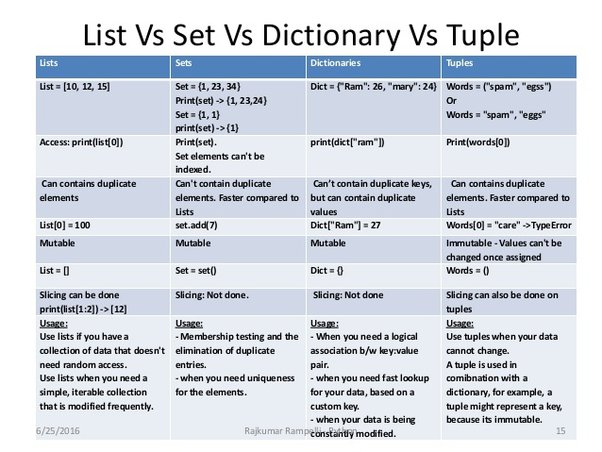Which is faster tuple or dictionary Python?
Which is faster tuple or dictionary Python?
In Python, tuples and dictionaries are two fundamental data structures that serve distinct purposes. The question of which one is faster depends on various factors, such as the context, usage, and requirements.
Tuple
A tuple is an immutable sequence of values in Python. It's a collection of items that can be accessed by index. Tuples are created using parentheses () and can contain any types of objects, including strings, integers, floats, and other tuples. Here are some key characteristics of tuples:
Dictionary
A dictionary (also known as a hash map or associative array) is an unordered collection of key-value pairs. In Python, dictionaries are created using curly braces {} and provide fast lookups by key. Here are some key characteristics of dictionaries:
keys(), values(), items(), and pop().
Performance Comparison
In general, tuples are faster than dictionaries for:
Accessing individual elements: Tuples provide constant-time access to elements (O(1)), whereas dictionaries typically require a hash lookup, which takes O(1) on average but can be O(n) in the worst case. Slicing and concatenation: Tuples support fast slicing (my_tuple[1:3]) and concatenation (my_tuple + (4, 5)) because they're just indexing into an array. Dictionaries don't support these operations efficiently.
However, dictionaries are generally faster for:
Lookup by key: Dictionaries provide fast lookups by key, making them ideal for caching or storing small amounts of data. Insertion and deletion: Dictionaries can be easily modified, which is useful when the structure of the data changes frequently.In Conclusion
When deciding between tuples and dictionaries, consider the following:
Use tuples for: Immutable collections of values Fast access to individual elements Slicing and concatenation operations Use dictionaries for: Unordered key-value pairs with fast lookups by key Mutable collections that require frequent modification Flexible operations likekeys(), values(), and items()
Remember that Python's built-in data structures are designed to serve specific purposes. Understanding the strengths and weaknesses of each can help you write more efficient, effective, and maintainable code.
What is the main difference between a tuple and a dictionary in Python?

I'd be happy to help!
In Python, tuple and dictionary are two fundamental data structures that serve distinct purposes.
Tuple
A tuple is an immutable collection of values, similar to a list. However, once created, the contents of a tuple cannot be modified; it remains unchanged throughout its existence. This is in contrast to lists, which can be modified dynamically by adding, removing, or changing elements. Tuples are often used when you need to store a fixed set of values that won't change over time.
Here are some key characteristics of tuples:
Immutable: Once created, a tuple's contents cannot be changed. Fixed size: A tuple has a fixed number of elements, which is determined at creation time. Ordered: Tuples maintain the order in which their elements were added. Indexable: You can access tuple elements using square brackets ([]) and their indices.
For example:
my_tuple = ('apple', 42, 3.14)
print(my_tuple) # Output: ('apple', 42, 3.14)
Attempting to modify the tuple will raise an error
try:
my_tuple[0] = 'banana'
except TypeError as e:
print(e) # Output: 'tuple' object does not support item assignment'
Dictionary
A dictionary is a mutable collection of key-value pairs, where each key is unique and maps to a specific value. This data structure allows you to store and manipulate key-value pairs dynamically.
Here are some essential characteristics of dictionaries:
Mutable: Dictionaries can be modified after creation by adding, removing, or changing key-value pairs. Dynamic size: The number of key-value pairs in a dictionary can change over time as elements are added or removed. Ordered (optional): Python 3.7 and later versions maintain the insertion order of dictionaries. However, older versions do not guarantee ordering. Indexable by keys: You can access dictionary values using their corresponding keys.For example:
my_dict = {'name': 'John', 'age': 30}
print(my_dict) # Output: {'name': 'John', 'age': 30}
Modifying the dictionary is allowed
my_dict['city'] = 'New York'
print(my_dict) # Output: {'name': 'John', 'age': 30, 'city': 'New York'}
In summary:
Tuples are immutable collections of values with a fixed size and order. They're useful for storing fixed sets of data that won't change. Dictionaries are mutable collections of key-value pairs with dynamic size and optional ordering. They're ideal for storing and manipulating data with flexible relationships between keys and values.While both data structures have their strengths, the choice between using a tuple or a dictionary usually depends on your specific programming needs and constraints.





























